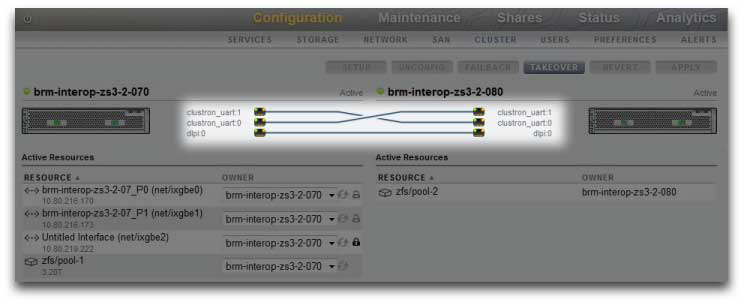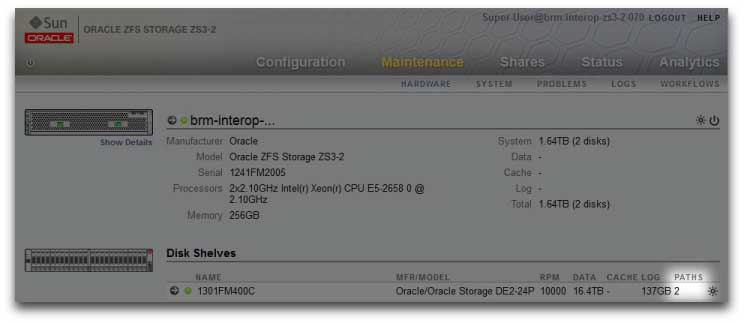| Skip Navigation Links | |
| Exit Print View | |

|
Oracle® ZFS Storage Appliance Administration Guide |
Chapter 1 Oracle ZFS Storage Appliance Overview
Chapter 3 Initial Configuration
Chapter 4 Network Configuration
Chapter 5 Storage Configuration
Chapter 6 Storage Area Network Configuration
Chapter 8 Setting ZFSSA Preferences
Chapter 10 Cluster Configuration
Understanding Cluster Resource Management
Configuration Changes in a Clustered Environment
Clustering Considerations for Storage
Clustering Considerations for Networking
Clustering Considerations for Infiniband
Clustering Redundant Path Scenarios
Estimating and Reducing Takeover Impact
Cluster Configuration Using the BUI
Configuring Clustering Using the CLI
Shutting Down a Clustered Configuration
ZS3-4 and 7x20 Cluster Cabling
Cluster Configuration BUI Page
Chapter 12 Shares, Projects, and Schema
A common failure mode in clustered systems is known as split-brain; in this condition, each of the clustered heads believes its peer has failed and attempts takeover. Absent additional logic, this condition can cause a broad spectrum of unexpected and destructive behavior that can be difficult to diagnose or correct. The canonical trigger for this condition is the failure of the communication medium shared by the heads; in the case of the Oracle ZFS Storage Appliance, this would occur if the cluster I/O links fail. In addition to the built-in triple-link redundancy (only a single link is required to avoid triggering takeover), the appliance software will also perform an arbitration procedure to determine which head should continue with takeover.
A number of arbitration mechanisms are employed by similar products; typically they entail the use of quorum disks (using SCSI reservations) or quorum servers. To support the use of ATA disks without the need for additional hardware, the Oracle ZFS Storage Appliance uses a different approach relying on the storage fabric itself to provide the required mutual exclusivity. The arbitration process consists of attempting to perform a SAS ZONE LOCK command on each of the visible SAS expanders in the storage fabric, in a predefined order. Whichever appliance is successful in its attempts to obtain all such locks will proceed with takeover; the other will reset itself. Since a clustered appliance that boots and detects that its peer is unreachable will attempt takeover and enter the same arbitration process, it will reset in a continuous loop until at least one cluster I/O link is restored. This ensures that the subsequent failure of the other head will not result in an extended outage. These SAS zone locks are released when failback is performed or approximately 10 seconds has elapsed since the head in the AKCS_OWNER state most recently renewed its own access to the storage fabric.
This arbitration mechanism is simple, inexpensive, and requires no additional hardware, but it relies on the clustered appliances both having access to at least one common SAS expander in the storage fabric. Under normal conditions, each appliance has access to all expanders, and arbitration will consist of taking at least two SAS zone locks. It is possible, however, to construct multiple-failure scenarios in which the appliances do not have access to any common expander. For example, if two of the SAS cables are removed or a JBOD is powered down, each appliance will have access to disjoint subsets of expanders. In this case, each appliance will successfully lock all reachable expanders, conclude that its peer has failed, and attempt to proceed with takeover. This can cause unrecoverable hangs due to disk affiliation conflicts and/or severe data corruption.
Note that while the consequences of this condition are severe, it can arise only in the case of multiple failures (often only in the case of 4 or more failures). The clustering solution embedded in the Oracle ZFS Storage Appliance is designed to ensure that there is no single point of failure, and to protect both data and availability against any plausible failure without adding undue cost or complexity to the system. It is still possible that massive multiple failures will cause loss of service and/or data, in much the same way that no RAID layout can protect against an unlimited number of disk failures.
Figure 10-8 Preventing Split-Brain

Fortunately, most such failure scenarios arise from human error and are completely preventable by installing the hardware properly and training staff in cluster setup and management best practices. Administrators should always ensure that all three cluster I/O links are connected and functional (see illustration), and that all storage cabling is connected as shown in the setup poster delivered with your appliances. It is particularly important that two paths are detected to each JBOD (see illustration) before placing the cluster into production and at all times afterward, with the obvious exception of temporary cabling changes to support capacity increases or replacement of faulty components. Administrators should use alerts to monitor the state of cluster interconnect links and JBOD paths and correct any failures promptly. Ensuring that proper connectivity is maintained will protect both availability and data integrity if a hardware or software component fails.
Figure 10-9 Cluster Two Paths
